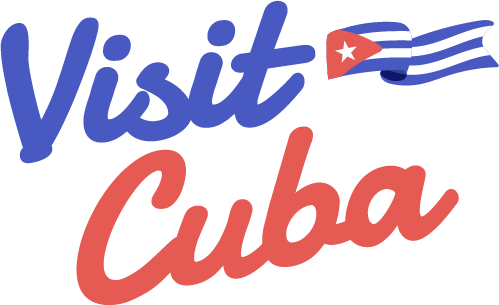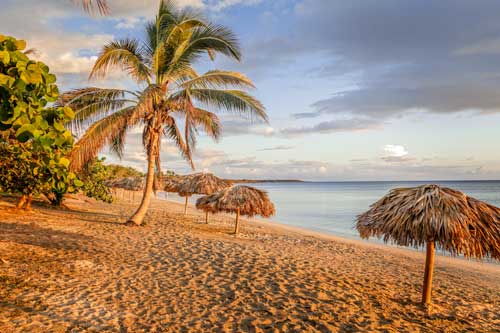Cuba Up Close
13 Fun Facts about Cuba
Men playing dominoes in Havana
Photo: Shutterstock
Discover curious and fun facts about Cuba and impress everyone with your knowledge
You've probably already heard stories about Cuba, but how much do you actually know about this Caribbean island nation? To help you dive deeper, we've assembled a collection of curious tidbits about Cuba. From quirky New Year’s traditions to the birth of a global cocktail legend, and well-known rhythms that’ll make your heart dance, get to know Cuba a little better with these 13 fun facts.
Almendrones, classic american cars in Havana
Photo: Shutterstock
1. More classic cars than anywhere else
In a world where the latest car models roll out every year, Cuba stands as a striking exception. The streets of this Cribbean island are a rolling time-capsule, teeming with vintage cars from the 1930s to 1950s, predominantly American brands like Chevrolet, Plymouth, Cadillac, Oldsmobile, Mercury, and Ford. These almendrones as locals call them due to their almond-like shape, not only add a nostalgic charm but are a crucial part of the public transportation system, often serving as shared taxis.
Nowhere else in the world will you witness such a congregation of operational classic cars in one place, and that's a fact. You'll even encounter vehicles from the former socialist bloc, like the sturdy Ladas.
Men playing dominoes in Havana
Photo: Shutterstock
2. Cubans are obsessed with dominoes
The clinking of domino tiles is the soundtrack to many a Cuban weekend, as the beloved game of dominoes holds a special place in the heart of the island. The tradition often spills onto the streets, with neighbors forming impromptu outdoor domino parlors. The stakes can get amusingly high in these friendly face-offs.
At Havana's famed Cristóbal Colón Necropolis, lies a testament to a domino duel of fate. Here rests Juana Martín de Martín, with a double three tile etched on her tombstone. Legend has it, Juana was a hair's breadth away from victory, only for her rival to snatch it away. Overcome with emotion, she met her match in more ways than one. Now, the double three marks her resting place, a whimsical nod to a game well played.
Havana streets
Photo: Shutterstock
3. Weird New Year Traditions
Cubans have a knack for ringing in the New Year with a splash of quirkiness! Their unique traditions are aimed at shooing away the old year's misfortunes and beckoning good luck for the fresh year. One popular ritual involves a thorough house cleaning, followed by tossing a bucket of water into the street, symbolically sweeping away the bad vibes - a kind of Cuban "clean slate."
But the weirdness doesn’t end there! Another fun fact about Cuba is the popular tradition of hitting the streets with a suitcase in tow at midnight, taking a stroll around the block. This Cuban cultural tradition is believed to attract travels and adventures in the year ahead. It's a common sight to see a neighborhood buzzing with suitcase-toting folks, all marching to the beat of New Year’s hope, dreaming of the voyages the new year might unfold.
Bee Hummingbird (Mellisuga helenae)
Photo: Shutterstock
4. Home to the worlds tiniest bird
Believe it or not, the diminutive bee hummingbird, or zunzuncito as it's locally known, holds the title for the smallest bird on Earth, and it's a native of Cuba! This pocket-sized fella measures less than 5 centimeters and can dart around at speeds close to 50 kilometers per hour. Known scientifically as Mellisuga helenae, it's also endearingly referred to as the "bee elf." Even their nests are pint-sized, with a diameter not exceeding 3 centimeters.
If fortune smiles upon you, spotting one of these tiny treasures fluttering from flower to flower is a sight to behold. Spotting a bee hummingbird is also considered a stroke of good luck by some locals.
Bartender making Mojitos at Bodeguita del Medio, Havana
Photo: Shutterstock
5. How’s this for a fun fact about Cuba? The Mojito origins here!
That’s right, this world-famous cocktail was invented right here in Cuba by none other than the feared pirate, Sir Francis Drake! This refreshing blend dates back to the 16th century when Drake and his crew landed on the Cuban shores. Faced with a host of ailments among his crew, various remedies were whipped up. The most popular and effective one turned out to be a local mixture of aguardiente de caña (a precursor to rum), mint, and sugar.
Over time, the recipe was refined, swapping in modern-day rum, and voila! The Mojito we know and adore was born. If reading this has left you with a hankering for this minty masterpiece, swing by La Bodeguita del Medio in Havana for what might just be the best Mojito on the island.
Cuban men surfing on the internet, Santa Clara
Photo: Shutterstock
6. Cuba's late bloomer digital dawn
Indeed, the digital wave of mobile internet only hit Cuba's shores in 2018 with the introduction of 3G networks. Before this digital shift, accessing the web was a bit of a field trip- folks had to leave the comfort of their homes and head to public browsing centers.
Nowadays, most hotels offer Wi-Fi, though the speed might feel a tad unhurried compared to what you're used to. And a heads-up if you're eyeing an Airbnb stay, Wi-Fi is likely a no-show unless it's listed as an amenity.
Train tracks in Trinidad
Photo: Shutterstock
7. First railways in Latin America
In stark contrast to its slow digital transition, Cuba was a trailblazer in rail transportation back in the day. The island nation pioneered the introduction of railways in Latin America on November 19, 1837, with a route from Havana to Bejucal. This significant stride placed Cuba as the first country in the region and the seventh globally to have operational trains.
The Capitol building in Havana
Photo: Shutterstock
8. A Russian diamond in Havana's Capitol
In Cuba, the starting point of all roads holds a shimmer of royal intrigue. Located in the heart of Havana's grand Capitol building, which was inaugurated in 1929, lies the official Kilometer Zero of the country, marked by a dazzling 25-carat diamond. This isn't just any gem; it's said to have been a part of Tsar Nicholas II's crown, brought to the island by a Turkish jeweler.
This sparkling relic has been a symbol of prosperity and pride for the locals ever since. Though today, visitors to the Capitol are greeted by a replica of the historic diamond, while the original is safely tucked away in the country's Central Bank.
Cuban frita burger
Photo: Shutterstock
9. No McDonalds or Starbucks here
Discovering the absence of McDonald's or Starbucks is among the intriguing facts about Cuba that underscore its unique charm. In today's globalized world, the golden arches of McDonald's and the green mermaid of Starbucks seem to have found their way to nearly every corner of the globe. Yet, venture to Cuba and you'll find a rare escape from these ubiquitous emblems of Western capitalism.
Yup, here in Cuba, the usual suspects like McDonald's, Starbucks, and KFC are nowhere to be found. But don’t worry, this absence only accentuates Cuba's culinary landscape, untouched by the standardization of global chains. Here, a quest for a coffee or a cheeseburger becomes an authentic experience. It's a chance to savor a cup of locally grown Cuban coffee, and when it comes to burgers, why not try a "frita" - a Cuban-style burger topped with shoestring potatoes.
Cuban men in Havana
Photo: Shutterstock
10. There’s a Cuban proverb for every occasion
Cubans has a rich tradition of using catchy sayings, or proverbs, to impart life lessons or reflect on common human experiences. Among the favorites is the phrase, “el que nace para tamal, del cielo le caen las hojas,” which loosely translates to, “if you’re born to be a tamale, the leaves will fall from the sky,” hinting at fate providing what’s necessary for one's destiny.
Then there’s the straightforward “al pan, pan y al vino, vino,” akin to the English “call a spade a spade,” urging folks to face situations for what they truly are. These colorful expressions, peppered throughout daily conversations, offer a fun and philosophical insight into the Cuban way of life. So, as you stroll through the lively streets of Cuba, keep an ear out for these catchy refranes.
Sunset over Topes de Collantes National Park
Photo: Shutterstock
11. The largest island in the Caribbean
Did you know that Cuba holds the title of the largest island in the Caribbean? The main island, with its crocodile-like shape, is part of an archipelago that includes various smaller islands and the special municipality of Isla de la Juventud.
In total, it covers a vast area of approximately 109,884 square kilometers. And here's a fun fact to visualize its size: the distance between the island's furthest points, Cabo de San Antonio and Maisí, measures about 1,422 kilometers! Fancy a road trip from tip to tail? Get your Spotify playlists ready because it's an 18-hour drive across this expansive Caribbean giant.
View of Cayo Coco
Photo: Shutterstock
12. Cuba has more than 4000 islands
Speaking about the size, Cuba isn't just a solitary island but a network of 4,195 islands and cays, each with its own unique charm. Embracing the main island are numerous smaller islands forming picturesque archipelagos.
Venture south, and you'll stumble upon the Jardines de la Reina and Canarreos Archipelago, each a haven of natural beauty. Along the northern coast stretches the Sabana-Camagüey Archipelago, a sprawling collection of around 2,517 cays and islands.
Street dancing in Havana
Photo: Shutterstock
13. Rumba was born and bred here in Cuba
In the lively dance halls of Cuba, the captivating rhythm of Rumba reverberates, telling tales of the island's rich African heritage. Birthed in the 19th century, this enthralling music and dance genre emerged as enslaved individuals shared their cultural vibrancy through spirited dances and rhythm-centric music, particularly in the regions of Matanzas and Havana.
The dance of Rumba, known for its suggestive steps and captivating hip movements, is not just a vivacious embodiment of Cuban culture, but a step into a rhythm deeply rooted in Cuba's history.
Written by Carlos Rojas.
Published November 2023.
Get to Know Cuba a Little Better
Seven Instagram Accounts That’ll Make You Want to Visit Cuba
Want to delve deeper into Cuba's culture, art, and local
A Traveler’s Guide to Cash, Currency and Costs in Cuba
Planning a trip to Cuba? Get savvy with your money
Six Essential Tips for Your Trip to Cuba 2023
From alternative accommodation to bypassing the restrictive internet in Cuba,
Seven Cuban Artists to Follow on Instagram Now
Dive into Cuba's dynamic art scene with our selection of
When Is the Best Time to Visit Cuba?
Planning a visit to Cuba? The island offers sunny skies
Visit the Museo de la Revolución, and Relive the Fight for Cuba
Havana’s Museo de la Revolución offers a thorough look at
Your Essential Guide to Cuban Culture & Customs
Immerse yourself in the rich Cuban culture that defines this
Categories
Tags
Share
Subscribe to our newsletter
Get more travel inspiration, tips and exclusive offers sent straight to your inbox

 Subscribe to our newsletter for the best monthly stories and insider guides about Cuba!
Subscribe to our newsletter for the best monthly stories and insider guides about Cuba!